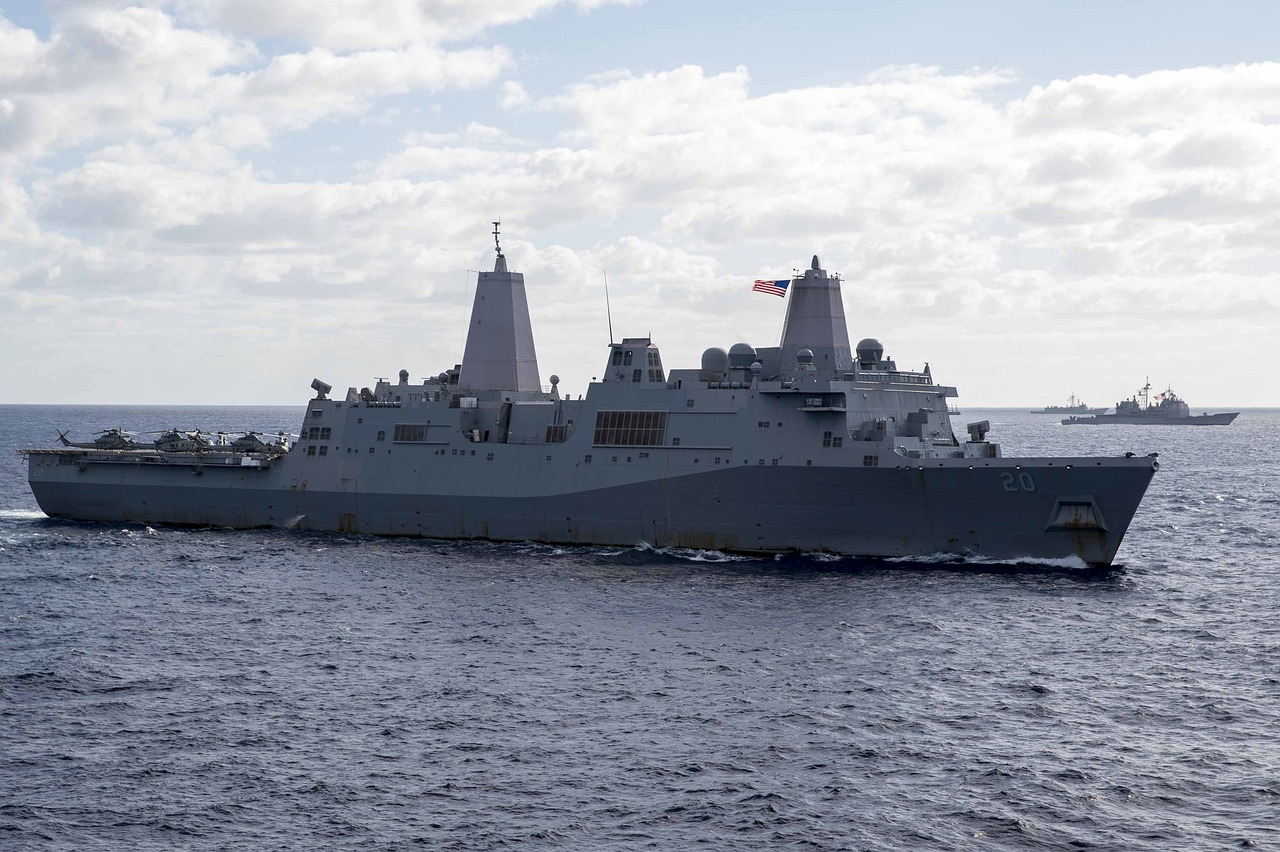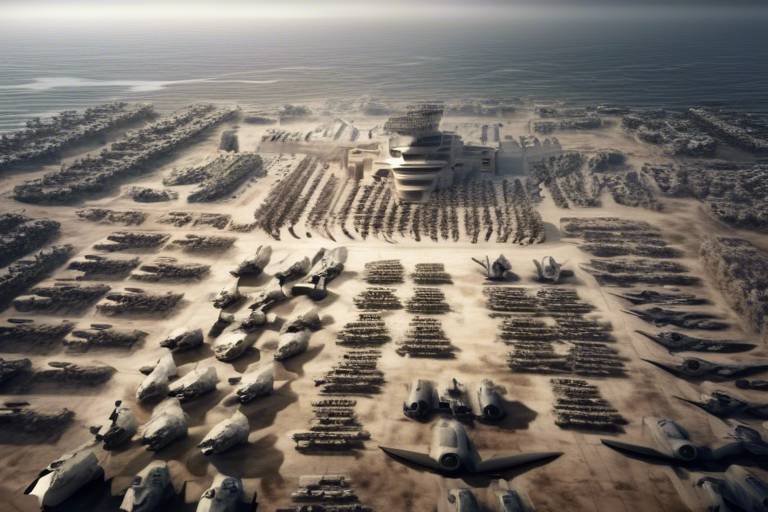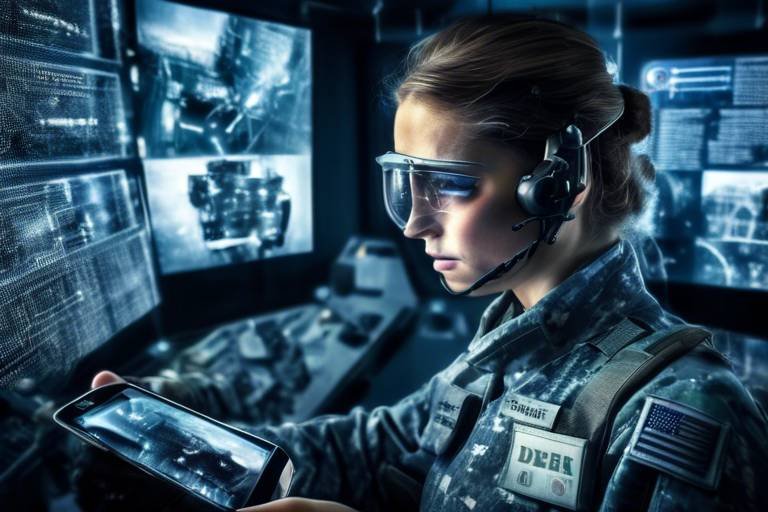Evaluating the Future of Advanced Naval Defense Systems
The world of naval defense is undergoing a dramatic transformation, driven by rapid technological advancements and shifting geopolitical landscapes. As nations around the globe invest heavily in their naval capabilities, it becomes crucial to evaluate how these changes will affect maritime security in the years to come. The future of naval defense systems is not just about the ships and submarines themselves; it's about the integrated technologies that will enhance their effectiveness, the strategies that will underpin their deployment, and the geopolitical implications that will arise from these advancements.
At the heart of this evolution is the integration of artificial intelligence (AI) into naval operations. AI is revolutionizing how naval forces operate, enabling them to make faster, more informed decisions in the heat of battle. Imagine a scenario where a naval fleet can analyze vast amounts of data in real-time, identifying threats and opportunities with unprecedented accuracy. This level of operational efficiency not only enhances the effectiveness of military engagements but also plays a critical role in deterrence strategies, as nations seek to project strength without escalating conflicts.
Moreover, emerging technologies such as unmanned systems, advanced sensors, and cyber capabilities are reshaping the landscape of naval warfare. Unmanned vehicles, including drones and autonomous submarines, are becoming essential components of modern fleets. They offer distinct advantages such as reduced risk to human life and the ability to conduct operations in hostile environments without direct human oversight. However, this shift towards unmanned systems also raises questions about cybersecurity and the legal frameworks governing their use, which must be addressed to ensure safe and effective deployment.
In addition to unmanned systems, advancements in sensor technologies are significantly enhancing situational awareness for naval forces. These sophisticated sensors allow for improved threat identification and tracking, enabling naval commanders to respond to emerging challenges with agility. As we consider the future of naval defense, it's essential to recognize that these technologies are not just tools; they represent a paradigm shift in how we approach maritime security.
As we delve deeper into the implications of these advancements, we must also consider the geopolitical ramifications. The race for naval superiority is intensifying, with nations investing heavily in advanced systems to bolster their maritime capabilities. This arms race could lead to heightened tensions and a reevaluation of international relations, as nations seek to assert their dominance on the global stage. On the flip side, we are also witnessing a trend towards collaborative defense strategies, where nations are joining forces to enhance collective security in response to shared threats.
In conclusion, the future of advanced naval defense systems is a complex tapestry woven from technological innovation, strategic imperatives, and geopolitical realities. As we navigate this evolving landscape, it is imperative that we remain vigilant and adaptable, ensuring that our naval forces are equipped to meet the challenges of tomorrow. The stakes are high, and the implications of these advancements will resonate far beyond the waters in which they operate.
- What role does AI play in naval defense?
AI enhances decision-making, threat detection, and operational efficiency, transforming naval warfare strategies.
- What are unmanned naval vehicles?
Unmanned vehicles, including drones and autonomous submarines, are vital assets that reduce risk and increase operational capabilities.
- What challenges do unmanned systems face?
Challenges include cybersecurity risks, legal limitations, and the need for effective integration with manned ships.
- How important is cybersecurity in naval defense?
As naval systems become interconnected, cybersecurity is crucial for protecting assets from cyber threats.
- What are the geopolitical implications of naval advancements?
Advancements can lead to an arms race among nations and foster collaborative defense strategies to enhance maritime security.

The Role of Artificial Intelligence in Naval Defense
Artificial intelligence (AI) is not just a buzzword; it's a game-changer in the realm of naval defense systems. Imagine a world where ships can autonomously analyze vast amounts of data, predict threats, and make decisions at lightning speed. This is not a scene out of a futuristic movie; it’s the reality we are stepping into as AI continues to revolutionize naval warfare strategies. By integrating AI into naval operations, military forces can enhance their decision-making capabilities, improve threat detection, and significantly boost operational efficiency.
One of the most significant impacts of AI is its ability to process and analyze data from numerous sources in real-time. This capability allows naval commanders to have a clearer picture of the battlefield, enabling them to make informed decisions swiftly. For instance, AI algorithms can sift through satellite imagery, radar data, and intelligence reports, identifying potential threats before they escalate. This proactive approach is akin to having a personal assistant who not only reminds you of your appointments but also anticipates your needs before you even ask.
Furthermore, AI is enhancing the effectiveness of unmanned systems in naval operations. Drones and autonomous vessels equipped with AI can conduct reconnaissance missions, gather intelligence, and even engage in combat scenarios without putting human lives at risk. This shift not only minimizes casualties but also allows for greater operational flexibility. However, the integration of AI into these systems is not without its challenges. Issues such as cybersecurity and the need for robust algorithms that can operate in unpredictable environments are paramount. The stakes are high, and the margin for error is minimal.
Moreover, the strategic implications of AI in naval defense are profound. Nations investing in AI technologies are not just enhancing their military capabilities; they are also reshaping the balance of power on a global scale. As countries race to develop advanced AI systems, we are witnessing a new kind of arms race—one driven not by physical weaponry but by technological supremacy. This competition raises questions about the future of warfare and the ethical considerations surrounding autonomous weaponry.
In summary, the role of artificial intelligence in naval defense is multifaceted and transformative. It offers unprecedented opportunities for enhancing operational effectiveness while also presenting significant challenges that must be addressed. As we look ahead, it is clear that AI will play a crucial role in shaping the future of maritime security, making it essential for naval forces to adapt and innovate continuously.

Emerging Technologies in Naval Warfare
In the ever-evolving arena of naval warfare, emerging technologies are not just enhancements; they are redefining the way naval forces operate. Innovations such as unmanned systems, advanced sensors, and cyber capabilities are at the forefront of this transformation, promising to change the dynamics of naval engagements. Imagine a battlefield where human error is minimized, and decisions are made at lightning speed—this is the reality that emerging technologies are creating. With these advancements, navies around the world are not only enhancing their capabilities but also reshaping their strategies to meet modern threats.
One of the most significant innovations in this realm is the rise of unmanned systems. These include various types of drones and autonomous submarines that can operate without direct human control, offering a range of tactical advantages. For instance, unmanned aerial vehicles (UAVs) can conduct reconnaissance missions in hostile areas without putting human lives at risk. Similarly, autonomous underwater vehicles (AUVs) can perform surveillance and mine detection tasks, significantly enhancing operational efficiency. The integration of these systems into naval fleets allows for greater flexibility and responsiveness in dynamic maritime environments.
Advanced sensor technologies are another critical component of this technological revolution. These sensors provide enhanced situational awareness, enabling naval forces to detect and identify threats with unprecedented precision. For example, radar systems have evolved to include advanced signal processing capabilities, allowing them to track multiple targets simultaneously, even in challenging conditions. The development of electro-optical and infrared sensors has also improved target identification, making it easier for naval forces to engage in precision strikes while minimizing collateral damage.
However, while these technologies present exciting opportunities, they also come with their own set of challenges. The integration of unmanned systems into existing naval operations raises questions about command and control. How do human operators effectively manage a fleet of unmanned vehicles? Moreover, the reliance on advanced sensors and networks makes naval forces vulnerable to cyber threats. As technology advances, so do the tactics employed by adversaries, leading to a constant game of cat and mouse.
To illustrate the impact of these emerging technologies, consider the following table that summarizes key innovations and their implications for naval warfare:
| Technology | Description | Implications |
|---|---|---|
| Unmanned Aerial Vehicles (UAVs) | Drones used for reconnaissance and strike missions. | Reduced risk to personnel, enhanced surveillance capabilities. |
| Autonomous Underwater Vehicles (AUVs) | Submarines that operate without human intervention. | Improved mine detection and reconnaissance in contested waters. |
| Advanced Sensor Systems | Radars and optics that provide real-time threat assessment. | Greater situational awareness, improved target engagement. |
As we look to the future, it's clear that the integration of these technologies will not only enhance naval capabilities but also necessitate a reevaluation of existing strategies. The question remains: how will nations adapt to these rapid advancements? Will they embrace collaboration, or will competition drive them to further develop their own technologies independently? The answers to these questions will shape the future of maritime security and the global balance of power.
- What are unmanned systems in naval warfare? Unmanned systems include drones and autonomous vehicles that operate without direct human control, enhancing operational efficiency and safety.
- How do advanced sensors improve naval operations? Advanced sensors provide real-time situational awareness, allowing for quicker threat detection and more precise engagements.
- What challenges do emerging technologies pose? Challenges include command and control integration, cybersecurity risks, and the need for new strategies to manage these technologies effectively.

Unmanned Naval Vehicles
Unmanned naval vehicles are rapidly becoming the backbone of modern naval operations, and it’s easy to see why. These innovative technologies, which include drones and autonomous submarines, are not just supplementary tools; they are transforming the very essence of naval warfare. Imagine a fleet where human operators are not confined to the vessels themselves but can control and monitor multiple unmanned units from a safe distance, allowing for greater flexibility and enhanced operational capabilities. This shift is akin to moving from a traditional chess game to a virtual reality version where the player can control multiple pieces at once, significantly increasing strategic options.
One of the key advantages of unmanned naval vehicles is their ability to operate in high-risk environments without putting human lives at risk. For instance, during reconnaissance missions, these vehicles can gather crucial intelligence on enemy positions without the threat of being shot down or captured. This capability not only enhances the safety of naval personnel but also provides a tactical edge in gathering real-time data. The use of drones for surveillance and targeting has already proven effective in various military operations, showcasing their potential to change the dynamics of naval engagements.
Moreover, the operational versatility of unmanned vehicles is astounding. They can be deployed for a variety of missions, including:
- Surveillance: Monitoring enemy movements and gathering intelligence.
- Logistics: Transporting supplies and equipment to remote locations.
- Combat: Engaging enemy forces with precision strikes.
However, it’s not all smooth sailing. The integration of unmanned systems into existing naval fleets presents several challenges. For example, there are concerns regarding cybersecurity, as these vehicles are often reliant on complex software and communication networks that can be vulnerable to hacking and electronic warfare. Additionally, the legal and ethical implications of using unmanned vehicles in combat situations are still being debated. Questions arise about accountability and the rules of engagement when machines are making life-and-death decisions.
In conclusion, unmanned naval vehicles represent a significant leap forward in naval warfare capabilities. Their ability to enhance operational efficiency and reduce risk to human life makes them invaluable assets in modern fleets. As nations continue to invest in these technologies, we can expect to see even more sophisticated unmanned systems that will further redefine naval engagements in the years to come.

Autonomous Surface Vessels
Autonomous surface vessels (ASVs) are rapidly emerging as game-changers in naval operations. Imagine a fleet of ships that can navigate, monitor, and perform missions without a human crew onboard. These vessels utilize cutting-edge technologies such as artificial intelligence, advanced sensors, and robust communication systems to operate independently or in conjunction with manned ships. The implications of ASVs extend far beyond mere convenience; they are set to redefine how naval forces conduct operations in a variety of environments.
One of the most significant advantages of autonomous surface vessels is their ability to undertake high-risk missions without endangering human lives. For instance, ASVs can be deployed for surveillance in contested waters, reconnaissance missions in piracy-prone regions, or even humanitarian assistance during natural disasters. Their capacity to operate in harsh conditions makes them invaluable assets in both peacetime and wartime scenarios.
Furthermore, ASVs can significantly enhance operational efficiency. By taking over routine tasks, such as patrolling, monitoring shipping lanes, or conducting environmental surveys, they free up manned vessels to focus on more complex operations. This division of labor allows navies to maximize their resources and optimize mission outcomes. For example, while an ASV is gathering intelligence in one area, a manned vessel can engage in strategic planning or direct combat operations elsewhere.
However, the integration of autonomous surface vessels into existing naval fleets is not without its challenges. One major concern is the legal and ethical implications of deploying unmanned systems in maritime warfare. Questions arise regarding accountability in the event of a mishap or unintended engagement with civilian vessels. Moreover, there are technical hurdles related to cybersecurity, as ASVs are susceptible to hacking and other cyber threats. Ensuring robust security protocols is essential to safeguard these vessels and their operations.
To illustrate the capabilities and potential applications of autonomous surface vessels, consider the following table that outlines some of their key features and uses:
| Feature | Application |
|---|---|
| AI Navigation | Enables autonomous route planning and obstacle avoidance |
| Remote Monitoring | Allows for real-time data collection and transmission back to command centers |
| Multi-Mission Capability | Can be configured for surveillance, logistics, or combat support |
| Cost-Effective Operations | Reduces the need for crewed vessels, saving on personnel costs and risks |
In summary, autonomous surface vessels represent a significant leap forward in naval technology. Their ability to operate independently, conduct high-risk missions, and enhance overall operational efficiency makes them a crucial component of future naval strategies. As we move forward, it will be essential for naval forces to address the challenges of integration and ensure that these innovative vessels can be deployed safely and effectively in the complex maritime environment.
- What are autonomous surface vessels? Autonomous surface vessels are unmanned ships that can operate independently using advanced technologies, including AI and sensors.
- What are the benefits of using ASVs? They can undertake high-risk missions without endangering crew members, enhance operational efficiency, and reduce costs.
- What challenges do ASVs face? Challenges include legal and ethical concerns, cybersecurity risks, and the need for effective integration with manned vessels.
- How do ASVs improve naval operations? They allow for real-time data collection, multi-mission capabilities, and cost-effective operations, ultimately optimizing mission outcomes.

Challenges of Unmanned Systems
The rise of unmanned systems in naval defense is nothing short of revolutionary, yet it doesn't come without its fair share of challenges. One of the most pressing issues is cybersecurity risks. As these unmanned vehicles become more integrated into naval operations, they also become more susceptible to cyber attacks. Imagine a scenario where a drone, crucial for reconnaissance, is hijacked by a hacker. This could lead to sensitive information being leaked, or worse, the drone being used against its own fleet. Therefore, ensuring robust cybersecurity measures is paramount for the safe deployment of these systems.
Another significant challenge is the legal limitations surrounding the use of unmanned systems. Different countries have varying regulations regarding their deployment, which can complicate international operations. For instance, while one nation may see the use of autonomous submarines as a game-changer, another might view it as a violation of maritime law. This discrepancy can create friction and hinder collaborative efforts among allied forces.
Furthermore, the integration with manned ships presents its own set of hurdles. While unmanned systems can operate independently, they often need to work alongside traditional vessels. This requires a seamless communication framework and operational protocols that can adapt to both types of ships. Without proper integration, there’s a risk of miscommunication during critical missions, which could lead to catastrophic outcomes.
Additionally, public perception plays a role in the deployment of unmanned systems. Many people harbor concerns about the ethical implications of using drones and autonomous vehicles in warfare. Questions arise about accountability in the event of a malfunction or unintended consequences, such as civilian casualties. These concerns can lead to pushback from the public and policymakers, potentially stalling advancements in this area.
In summary, while unmanned systems offer a plethora of advantages for naval operations, their deployment is fraught with challenges that must be addressed. From cybersecurity threats and legal issues to integration difficulties and public perception, the path forward requires careful navigation. Addressing these challenges head-on will not only enhance the effectiveness of unmanned systems but also ensure they are used responsibly and ethically in the complex landscape of modern naval warfare.
- What are unmanned systems in naval defense? Unmanned systems refer to vehicles such as drones and autonomous submarines that can operate without a human crew on board, providing significant advantages in surveillance and combat.
- What cybersecurity risks do unmanned systems face? Unmanned systems are vulnerable to hacking and cyber attacks, which can compromise their operations and lead to sensitive data being exposed.
- How do legal limitations affect the use of unmanned systems? Different countries have varying regulations regarding unmanned systems, which can complicate their deployment and use in international waters.
- What are the integration challenges of unmanned systems? Integrating unmanned systems with manned vessels requires effective communication frameworks and operational protocols to ensure seamless cooperation during missions.
- How does public perception impact unmanned systems? Public concerns regarding the ethical implications of using unmanned systems in warfare can lead to resistance against their deployment and create challenges for policymakers.

Advanced Sensor Technologies
In the rapidly evolving world of naval warfare, are playing a pivotal role in enhancing situational awareness and threat identification. These innovations are not just about keeping pace with the enemy; they are about staying several steps ahead. Imagine a naval fleet equipped with sensors that can detect threats from hundreds of miles away, providing commanders with crucial data to make informed decisions in real-time. This is no longer a distant dream; it is becoming a reality.
Modern naval operations leverage a variety of sensor technologies, including radar systems, sonar devices, and electro-optical sensors. Each of these technologies contributes to a comprehensive understanding of the maritime environment. For instance, radar systems can track aerial and surface targets, while sonar is essential for underwater surveillance. Electro-optical sensors, on the other hand, provide high-resolution imagery that can be vital for reconnaissance missions.
One of the most exciting developments in sensor technology is the integration of Artificial Intelligence (AI). AI enhances the processing capabilities of sensors, allowing for quicker data analysis and improved threat detection. With machine learning algorithms, these systems can identify patterns and anomalies in vast amounts of data, significantly reducing the time it takes to respond to potential threats. This integration not only boosts operational efficiency but also minimizes human error, which can be crucial in high-stakes situations.
Moreover, the use of networked sensor systems is transforming how naval forces operate. By connecting various sensors across different platforms, naval commanders can achieve a unified operational picture. This interconnectedness allows for better coordination and response strategies, especially in joint operations with allied forces. For example, a naval vessel can share real-time data with aircraft and ground forces, creating a comprehensive view of the battlefield.
However, the implementation of these advanced sensor technologies is not without its challenges. The sheer volume of data generated can be overwhelming, necessitating robust data management systems. Additionally, the reliance on technology raises concerns about cybersecurity, as adversaries may attempt to disrupt or manipulate sensor networks. Therefore, investing in cybersecurity measures is as crucial as developing the sensors themselves.
In summary, advanced sensor technologies are revolutionizing naval warfare by enhancing situational awareness, improving threat detection, and fostering better coordination among forces. As these technologies continue to evolve, they will undoubtedly play a critical role in shaping the future of maritime security.
- What are advanced sensor technologies?
Advanced sensor technologies refer to modern devices and systems that enhance the ability to detect, track, and analyze threats in naval operations. - How does AI improve sensor technologies?
AI enhances sensor technologies by enabling faster data processing, better pattern recognition, and reducing human error in threat detection. - What challenges do advanced sensors face?
Challenges include data overload, cybersecurity risks, and the need for robust data management systems to handle the information generated. - Why is networked sensor systems important?
Networked sensor systems allow for real-time data sharing and coordination among different military branches, improving operational effectiveness.

Cybersecurity in Naval Defense
As we navigate through the 21st century, cybersecurity has become an indispensable element of naval defense. The integration of advanced technologies in naval systems has significantly enhanced operational capabilities, but it has also introduced a myriad of vulnerabilities. Imagine a vast ocean where ships are not only battling the elements but also facing invisible adversaries in the form of cyber threats. This duality of warfare—traditional and digital—requires a robust cybersecurity framework to protect naval assets from potential breaches.
The interconnectedness of modern naval systems means that a single cyber incident can have catastrophic consequences. For instance, if an enemy were to successfully infiltrate a naval fleet's communication systems, they could disrupt operations, mislead commanders, or even take control of critical systems. The stakes are incredibly high, and understanding the threat landscape is crucial for effective naval cybersecurity. Various types of cyber threats, including malware, phishing, and denial-of-service attacks, are constantly evolving, making it imperative for naval forces to stay one step ahead.
To combat these threats, naval forces must implement a comprehensive cybersecurity strategy. This includes regular assessments of vulnerabilities, continuous monitoring of networks, and rigorous training for personnel. Moreover, collaboration with technology partners to develop robust cybersecurity tools is essential. For example, employing advanced threat detection systems can help identify and neutralize attacks before they cause harm. The table below outlines some common cyber threats and their potential impact on naval operations:
| Cyber Threat | Description | Potential Impact |
|---|---|---|
| Malware | Malicious software designed to disrupt, damage, or gain unauthorized access to systems. | System failures, data breaches, operational paralysis. |
| Phishing | A fraudulent attempt to obtain sensitive information by disguising as a trustworthy entity. | Loss of sensitive data, unauthorized access to systems. |
| Denial-of-Service (DoS) | An attack intended to make a machine or network resource unavailable to its intended users. | Service outages, disruption of operations. |
Implementing best practices in cybersecurity can significantly enhance the resilience of naval operations. These practices include establishing a culture of cybersecurity awareness among personnel, regularly updating software to patch vulnerabilities, and conducting simulated cyber attack drills to prepare for real-world scenarios. The integration of artificial intelligence in cybersecurity measures is also proving to be a game-changer. AI can analyze vast amounts of data to detect anomalies and predict potential threats, allowing naval forces to respond proactively.
As we look to the future, the importance of cybersecurity in naval defense cannot be overstated. The maritime domain is increasingly becoming a battleground not just for ships and submarines, but for information and data. Protecting our naval assets from cyber threats is not just about technology; it’s about strategy, training, and a commitment to staying ahead in this ever-evolving landscape. In the words of Sun Tzu, "The supreme art of war is to subdue the enemy without fighting." In the realm of naval defense, this means mastering the art of cybersecurity.
- What are the main cyber threats faced by naval forces? Naval forces face threats such as malware, phishing, and denial-of-service attacks, which can disrupt operations and compromise sensitive information.
- How can naval forces improve their cybersecurity posture? By implementing best practices such as regular training, software updates, and advanced threat detection systems, naval forces can enhance their cybersecurity resilience.
- Why is cybersecurity important in naval defense? As naval systems become more interconnected, the potential for cyber attacks increases, making it essential to protect assets and ensure operational integrity.

Threat Landscape in Naval Cybersecurity
The realm of naval cybersecurity is becoming increasingly complex and challenging as the maritime domain evolves. As naval forces integrate more sophisticated technologies, the risk of cyber threats escalates. These threats can range from state-sponsored attacks to individual hackers, all aiming to exploit vulnerabilities in naval systems. The implications of such breaches can be catastrophic, potentially compromising national security, naval operations, and the safety of personnel.
One of the most pressing issues is the rise of state-sponsored cyber warfare. Countries are investing heavily in cyber capabilities to disrupt the operations of their adversaries. This includes targeting critical naval infrastructure, such as communication systems and weaponry, which can lead to significant operational failures. Additionally, non-state actors are also a concern, as they may engage in cyber espionage or sabotage to achieve their objectives.
Moreover, the interconnected nature of modern naval systems introduces new vulnerabilities. Many naval vessels now rely on complex networks that connect various systems, including navigation, weapon control, and logistics. While this interconnectedness enhances operational efficiency, it also creates multiple entry points for cyber attackers. As a result, any breach in one system can potentially compromise the entire fleet.
To better understand the diverse threats faced by naval forces, let's take a look at some of the key categories of cyber threats:
- Malware Attacks: Malicious software designed to disrupt, damage, or gain unauthorized access to computer systems.
- Phishing Scams: Deceptive attempts to obtain sensitive information by masquerading as a trustworthy entity.
- Denial of Service (DoS) Attacks: Attempts to make a machine or network resource unavailable to its intended users by overwhelming it with traffic.
- Insider Threats: Risks posed by individuals within the organization who may intentionally or unintentionally cause harm to naval systems.
As the threat landscape continues to evolve, naval forces must adopt a proactive approach to cybersecurity. This includes investing in advanced security technologies, conducting regular vulnerability assessments, and training personnel to recognize and respond to cyber threats effectively. Furthermore, collaboration among nations is crucial to share intelligence and develop collective defense strategies against cyber adversaries.
In conclusion, understanding the threat landscape in naval cybersecurity is essential for safeguarding maritime operations. As cyber threats become more sophisticated, naval forces must remain vigilant and adaptable to protect their assets and maintain operational readiness.
- What are the main cyber threats faced by naval forces? Naval forces face various cyber threats, including state-sponsored attacks, malware, phishing scams, and insider threats.
- How can naval forces enhance their cybersecurity? By investing in advanced security technologies, conducting regular assessments, and training personnel to recognize cyber threats.
- Why is collaboration important in naval cybersecurity? Collaboration allows nations to share intelligence and develop collective defense strategies against common cyber adversaries.

Best Practices for Cyber Defense
In the rapidly evolving landscape of naval defense, cybersecurity has become a cornerstone in safeguarding assets and operations. As naval forces increasingly rely on interconnected systems, the risk of cyber threats looms larger than ever. To effectively protect these systems, it is essential to implement a robust cybersecurity framework that includes several best practices.
First and foremost, regular training and awareness programs for personnel are crucial. Human error is often the weakest link in cybersecurity. By conducting ongoing training sessions, naval forces can ensure that all personnel are aware of the latest phishing techniques and social engineering tactics used by cyber adversaries. This proactive approach not only empowers the crew but also fosters a culture of vigilance.
Furthermore, adopting a layered security approach can significantly enhance defense mechanisms. This involves deploying multiple security measures at various levels of the network, such as firewalls, intrusion detection systems, and data encryption. By creating layers of defense, even if one measure fails, others can still provide protection. For instance, if an unauthorized user gains access to the network, robust encryption can safeguard sensitive data from being easily compromised.
Another vital practice is the implementation of regular system updates and patch management. Cybercriminals often exploit known vulnerabilities in software. By ensuring that all systems are regularly updated, naval forces can close these gaps and minimize the risk of breaches. This includes not only operating systems but also applications and firmware used in naval operations.
Additionally, establishing a comprehensive incident response plan is essential. This plan should outline the steps to take in the event of a cyber incident, including communication protocols, containment measures, and recovery strategies. Having a well-defined plan allows naval forces to respond swiftly and effectively, minimizing damage and restoring operations as quickly as possible.
Moreover, conducting regular security audits and assessments can help identify vulnerabilities before they can be exploited. These audits should evaluate both technical and procedural aspects of cybersecurity, ensuring that all areas are covered. By regularly assessing the security posture, naval forces can adapt to emerging threats and continuously improve their defenses.
Finally, collaboration with other organizations, including government agencies and private cybersecurity firms, can enhance overall security. Sharing intelligence about threats and vulnerabilities can lead to more effective countermeasures. Joint training exercises can also help prepare personnel for real-world scenarios, ensuring that they are ready to face potential cyber threats.
In conclusion, the best practices for cyber defense in naval operations revolve around a combination of training, layered security, regular updates, incident response planning, security audits, and collaboration. By adopting these strategies, naval forces can significantly improve their resilience against cyber threats and maintain the integrity of their operations.
- What are the most common cyber threats faced by naval forces? Cyber threats can range from phishing attacks to ransomware and advanced persistent threats (APTs) that target critical infrastructure.
- How often should cybersecurity training be conducted? Regular training should be conducted at least quarterly, with ongoing updates as new threats emerge.
- What is the importance of incident response plans? Incident response plans are crucial for minimizing the impact of cyber incidents and ensuring a swift recovery.
- Can collaboration with private firms enhance naval cybersecurity? Yes, collaboration can provide access to specialized expertise and threat intelligence that can strengthen overall security measures.

Geopolitical Implications of Naval Advancements
The advancements in naval defense systems are not just technological marvels; they are reshaping the geopolitical landscape in profound ways. As nations invest heavily in cutting-edge naval capabilities, the balance of power is shifting, leading to new alliances, rivalries, and strategic postures. The race for naval superiority is becoming a defining feature of international relations, with implications that echo across global waters.
One of the most significant outcomes of these advancements is the emergence of a naval arms race. Countries are ramping up their naval capabilities not just for defense but as a means of asserting their influence on the global stage. For instance, nations like China and Russia are modernizing their fleets with advanced submarines, aircraft carriers, and unmanned systems, aiming to challenge the dominance of traditional naval powers such as the United States. This arms race is characterized by:
- Increased Military Spending: Nations are allocating larger portions of their budgets to naval enhancements.
- Technological Innovation: The focus is on developing advanced systems that can outperform existing technologies.
- Strategic Partnerships: Countries are forming alliances to share technology and resources, further complicating the geopolitical landscape.
Moreover, these advancements are influencing maritime security strategies among nations. As naval capabilities grow, so does the need for nations to protect their interests in increasingly contested waters. The South China Sea, for example, has become a flashpoint where territorial disputes are escalating due to military buildups. Here, the implications of naval advancements are palpable:
- Increased Tensions: The presence of advanced naval assets can lead to confrontations at sea.
- Diplomatic Maneuvering: Nations must engage in complex diplomatic negotiations to avoid conflict.
- Regional Alliances: Smaller nations are banding together to counterbalance larger powers.
Furthermore, the geopolitical implications extend beyond mere military might. They also encompass economic considerations. Control over maritime trade routes, which are vital for global commerce, is increasingly at stake. Countries with superior naval capabilities can exert influence over these routes, impacting global trade dynamics. This situation raises questions about freedom of navigation and the rights of nations to operate in international waters. For instance, the United States has emphasized its commitment to maintaining freedom of navigation in the face of aggressive posturing by other nations.
Additionally, the integration of advanced technologies, such as artificial intelligence and cyber capabilities, is adding a new layer of complexity to naval operations. These technologies not only enhance operational efficiency but also introduce vulnerabilities that adversaries can exploit. As a result, nations must navigate a landscape where technological advancements can lead to both strategic advantages and unforeseen risks.
In conclusion, the geopolitical implications of advancements in naval defense systems are vast and multifaceted. As nations continue to innovate and invest in their naval capabilities, the international community must grapple with the shifting tides of power, the complexities of maritime security, and the intricacies of global trade. The future of naval warfare is not just about who has the most advanced ships; it's about understanding the broader implications of these advancements on global peace and stability.
Q: How are naval advancements affecting international relations?
A: Naval advancements are leading to a naval arms race, increased tensions in disputed waters, and the formation of new strategic alliances, significantly impacting international relations.
Q: What role does technology play in modern naval warfare?
A: Technology, including AI and unmanned systems, enhances operational capabilities but also introduces new vulnerabilities, creating a complex environment for naval operations.
Q: Why is maritime security becoming more crucial?
A: As nations invest in advanced naval systems, protecting vital trade routes and ensuring freedom of navigation has become essential for maintaining global commerce and stability.

Naval Arms Race Among Nations
The global landscape of naval defense is witnessing an unprecedented arms race, as nations scramble to bolster their maritime capabilities. This surge in investment is not merely a reaction to current threats but also a strategic maneuver to assert dominance over key maritime routes and resources. Countries like the United States, China, and Russia are at the forefront, each vying for technological superiority and enhanced naval power. But what drives this race, and what are its implications for global security?
At the heart of this naval arms race lies geopolitical tension. As nations expand their territorial claims and maritime interests, the need for a robust naval presence becomes paramount. For instance, China's assertiveness in the South China Sea has prompted neighboring countries to enhance their naval capabilities, leading to a ripple effect across the region. This not only escalates military spending but also increases the likelihood of miscalculations or confrontations at sea.
Moreover, the advancements in naval technology are a double-edged sword. While they provide nations with enhanced operational capabilities, they also create a sense of insecurity among rival states. As each nation races to develop cutting-edge technologies—such as stealth submarines, hypersonic missiles, and advanced unmanned systems—the balance of power is continually shifting. This can lead to a precarious situation where nations feel compelled to respond to each other's advancements, perpetuating the cycle of competition.
To illustrate this arms race, consider the following table that highlights the naval spending of key nations in recent years:
| Country | Naval Defense Spending (2023) | Key Developments |
|---|---|---|
| United States | $234 billion | New aircraft carriers, advanced destroyers |
| China | $215 billion | Expansion of naval fleet, stealth submarines |
| Russia | $75 billion | Modernization of fleet, new missile systems |
| India | $50 billion | Indigenous aircraft carriers, submarines |
As seen in the table, the financial commitment to naval defense is substantial, and it reflects a strategic priority for these nations. The implications of this arms race extend beyond mere numbers; they influence international relations and can lead to a reconfiguration of alliances. Countries may seek partnerships or alliances to counterbalance the capabilities of rival nations, further complicating the geopolitical landscape.
In conclusion, the naval arms race among nations is a multifaceted issue driven by geopolitical ambitions, technological advancements, and the quest for dominance over vital maritime regions. As countries continue to invest heavily in their naval capabilities, the global community must remain vigilant, fostering dialogues and agreements to mitigate the risks associated with this competitive environment.
- What is the primary reason for the naval arms race?
The primary reason for the naval arms race is geopolitical tension and the need for nations to secure their maritime interests and territorial claims. - Which countries are leading the naval arms race?
The United States, China, and Russia are currently leading the naval arms race, with significant investments in advanced naval technologies. - How does this arms race affect global security?
The arms race can lead to increased military tensions, the potential for miscalculations, and a reconfiguration of international alliances, impacting overall global security.

Collaborative Defense Strategies
In today's rapidly changing geopolitical landscape, the concept of has gained unprecedented significance. Nations around the globe are recognizing that the complexities of modern threats, especially in maritime domains, cannot be effectively addressed in isolation. This realization has led to a surge in joint military exercises, information sharing, and strategic partnerships aimed at enhancing collective security. But what does this really mean for global defense?
At the heart of these collaborative efforts is the need for interoperability. This refers to the ability of different nations' military forces to operate together seamlessly. Imagine a complex dance where every participant must be in sync, moving together to achieve a common goal. In the context of naval defense, this means that ships from various countries should be able to communicate effectively, share intelligence in real-time, and coordinate their actions during joint operations. Such interoperability is not just a technical requirement; it’s a strategic imperative that can determine the success of collective maritime missions.
One prominent example of this collaborative approach is the Rim of the Pacific Exercise (RIMPAC), which is the largest international maritime exercise in the world. Conducted biennially, RIMPAC brings together naval forces from multiple countries to enhance their operational capabilities and foster relationships. This exercise not only improves tactical skills but also builds trust and understanding among participating nations, which is crucial in times of crisis.
Moreover, the establishment of multinational coalitions is becoming increasingly common. These coalitions allow for the pooling of resources, expertise, and technology, creating a more robust defense posture. For instance, the European Union’s Naval Force Operation Atalanta exemplifies how countries can collaborate to combat piracy off the coast of Somalia. By working together, these nations have significantly reduced piracy incidents, showcasing the effectiveness of united efforts in addressing common threats.
However, while the benefits of collaborative defense strategies are clear, they are not without challenges. Nations must navigate issues such as political differences, varying levels of military capability, and the complexities of command structures. Additionally, the potential for conflicting national interests can complicate cooperation. To mitigate these challenges, it is essential for countries to engage in open dialogue and establish clear frameworks for collaboration that prioritize shared security goals.
In conclusion, as the maritime security landscape continues to evolve, the importance of collaborative defense strategies cannot be overstated. By embracing partnerships and fostering interoperability, nations can enhance their collective security and respond more effectively to emerging threats. The future of naval defense lies in unity, and through collaboration, nations can create a formidable force capable of safeguarding their interests on the high seas.
- What are collaborative defense strategies? Collaborative defense strategies involve nations working together to enhance security through joint exercises, information sharing, and strategic partnerships.
- Why is interoperability important? Interoperability ensures that military forces from different countries can operate together effectively, which is crucial for the success of joint operations.
- Can you give an example of a collaborative defense exercise? The Rim of the Pacific Exercise (RIMPAC) is a notable example, involving naval forces from multiple countries to improve operational capabilities.
- What challenges do nations face in collaboration? Challenges include political differences, varying military capabilities, and potential conflicts of national interests.
Frequently Asked Questions
- What is the role of artificial intelligence in naval defense?
Artificial intelligence (AI) is transforming naval defense by enhancing decision-making processes, improving threat detection capabilities, and increasing operational efficiency. With AI, naval forces can analyze vast amounts of data in real-time, allowing for quicker responses to potential threats and more strategic planning in naval operations.
- How are unmanned naval vehicles changing warfare?
Unmanned naval vehicles, such as drones and autonomous submarines, are revolutionizing naval warfare by providing new capabilities that enhance surveillance, reconnaissance, and even combat operations. They offer significant advantages, including reduced risk to human life and the ability to operate in environments that may be too dangerous for manned vessels.
- What challenges do unmanned systems face?
Despite their many advantages, unmanned systems encounter several challenges, including cybersecurity risks, legal limitations, and integration difficulties with existing manned fleets. Addressing these challenges is essential for the effective deployment of unmanned technologies in naval operations.
- Why is cybersecurity important in naval defense?
As naval systems become more interconnected, the threat of cyberattacks increases. Cybersecurity is vital to protect sensitive data and maintain operational integrity. Ensuring robust cybersecurity measures helps safeguard naval assets from potential vulnerabilities and attacks that could compromise mission success.
- What are the best practices for enhancing naval cybersecurity?
Implementing best practices for cybersecurity in naval defense involves adopting comprehensive security frameworks, conducting regular vulnerability assessments, and training personnel on cyber defense protocols. These strategies are essential in building resilience against cyber threats and ensuring the safety of naval operations.
- How do advancements in naval defense systems affect global power dynamics?
Advancements in naval defense systems can significantly alter global power dynamics by prompting nations to invest heavily in their naval capabilities. This can lead to an arms race as countries strive to maintain or gain superiority at sea, influencing international relations and maritime security strategies.
- What are collaborative defense strategies in naval operations?
Collaborative defense strategies involve nations working together to enhance maritime security through joint exercises, partnerships, and sharing of intelligence. These collaborations are increasingly important in addressing common threats and fostering a collective approach to naval defense.



















